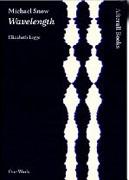SNOW: MICHAEL SNOW. WAVELENGTH

Autor/es
- EAN: 9781846380563
- ISBN: 978-1-84638-056-3
- Editorial: MIT PRESS
- Año de la edición: 2009
- Encuadernación: Rústica
- Medidas: 20 X 15 cm.
- Páginas: 112
- Materias:
nuevas vanguardias, técnicas mixtas, nuevos medios
video, multimedia, artes visuales
Sin stock. Envío en 15/30 días
pvp 16,87 €
In 1966, at the height of minimal art in New York, artist Michael Snow chose not to make another object to be placed in a room but instead spent a year planning a film of a room: Wavelength, a forty-five-minute more or less straight-line zoom from the near to the far wall of a loft space, accompanied by a rising sine wave. In this illustrated study, Elizabeth Legge describes Wavelength as a film of virtuosically managed tensions, sensuous beauty, subtle light and color, and recession into perspectival depth. At the same time, she points out, it is also austere: the loft space where the action unfolds could be the last clerical outpost of a defunct business. The zoom is punctuated by what Snow laconically called "4 human events": a woman directs two men who carry in a bookcase and place it against the left wall of the room; two women come in and listen to the Beatles' "Strawberry Fields" on the radio; a man briefly appears after protracted crashing and glass-breaking noises, wheels around, and drops dead; a young woman comes into the room and makes a frightened telephone call reporting the dead man ("And he doesn't look drunk, he looks dead."). Wavelength won the grand prize for experimental film at Knokke-le-Zoute in 1967, and it was crucial to critics' efforts to establish a vocabulary for temporal art. It was a "wavelength" that could stand up to the French new wave, and it has has functioned ever since as a touchstone for art and film studies, and as a blue screen in front of which a range of ideological and intellectual dramas have been played.

